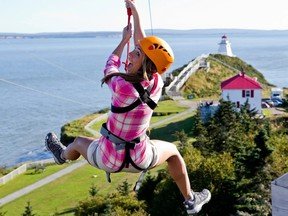Article content
Eight New Brunswick tourist attractions are joining the federal government’s offer of free or discounted admission this summer.

Want smarter insights in your inbox? Sign up for our weekly newsletters to get only what matters to enterprise AI, data, and security leaders. Subscribe Now
As AI applications increasingly permeate enterprise operations, from enhancing patient care through advanced medical imaging to powering complex fraud detection models and even aiding wildlife conservation, a critical bottleneck often emerges: data storage.
During VentureBeat’s Transform 2025, Greg Matson, head of products and marketing, Solidigm and Roger Cummings, CEO of PEAK:AIO spoke with Michael Stewart, managing partner at M12 about how innovations in storage technology enables enterprise AI use cases in healthcare.
The MONAI framework is a breakthrough in medical imaging, building it faster, more safely, and more securely. Advances in storage technology is what enables researchers to build on top of this framework, iterate and innovate quickly. PEAK:AIO partnered with Solidgm to integrate power-efficient, performant, and high-capacity storage which enabled MONAI to store more than two million full-body CT scans on a single node within their IT environment.
“As enterprise AI infrastructure evolves rapidly, storage hardware increasingly needs to be tailored to specific use cases, depending on where they are in the AI data pipeline,” Matson said. “The type of use case we talked about with MONAI, an edge-use case, as well as the feeding of a training cluster, are well served by very high-capacity solid-state storage solutions, but the actual inference and model training need something different. That’s a very high-performance, very high I/O-per-second requirement from the SSD. For us, RAG is bifurcating the types of products that we make and the types of integrations we have to make with the software.”
For peak performance at the edge, it’s critical to scale storage down to a single node, in order to bring inference closer to the data. And what’s key is removing memory bottlenecks. That can be done by making memory a part of the AI infrastructure, in order to scale it along with data and metadata. The proximity of data to compute dramatically increases the time to insight.
“You see all the huge deployments, the big green field data centers for AI, using very specific hardware designs to be able to bring the data as close as possible to the GPUs,” Matson said. “They’ve been building out their data centers with very high-capacity solid-state storage, to bring petabyte-level storage, very accessible at very high speeds, to the GPUs. Now, that same technology is happening in a microcosm at the edge and in the enterprise.”
It’s becoming critical to purchasers of AI systems to ensure you’re getting the most performance out of your system by running it on all solid state. That allows you to bring huge amounts of data, and enables incredible processing power in a small system at the edge.
“It’s imperative that we provide solutions that are open, scalable, and at memory speed, using some of the latest and greatest technology out there to do that,” Cummings said. “That’s our goal as a company, to provide that openness, that speed, and the scale that organizations need. I think you’re going to see the economies match that as well.”
For the overall training and inference data pipeline, and within inference itself, hardware needs will keep increasing, whether it’s a very high-speed SSD or a very high-capacity solution that’s power efficient.
“I would say it’s going to move even further toward very high-capacity, whether it’s a one-petabyte SSD out a couple of years from now that runs at very low power and that can basically replace four times as many hard drives, or a very high-performance product that’s almost near memory speeds,” Matson said. “You’ll see that the big GPU vendors are looking at how to define the next storage architecture, so that it can help augment, very closely, the HBM in the system. What was a general-purpose SSD in cloud computing is now bifurcating into capacity and performance. We’ll keep doing that further out in both directions over the next five or 10 years.”
Trusted News Since 1995
A service for travel industry professionals
·
Monday, July 21, 2025
·
832,504,696
Articles
·
3+ Million Readers
Shocking footage posted to the Instagram account TouronsOfYellowstone (@touronsofyellowstone) brought attention to the moment four bikers cut through the Grand Prismatic at Yellowstone National Park.
“The 4 of them were biking from the tree line towards the boardwalk when, as they were nearing the actual hot springs, several people yelled at them to turn around,” the caption reads.
The Grand Prismatic in Yellowstone is the largest hot spring in the United States, known for its geysers. Microbial mats have played a major role in scientific research and help preserve the unique geothermal ecosystem. Biking over the springs is not only dangerous for bikers, but it also has considerable impacts on the landscape.
“I have never seen anything like this in Yellowstone ever after many decades,” TouronsOfYellowstone wrote. “This is next level! I just don’t understand the thought process these people had to think that it was okay for them to not just walk but to ride their bikes on the Grand Prismatic.”
Infiltrating ecosystems meant to be preserved can lead to a slew of legal issues. Some people who have done so have ended up with $5,000 in fines. Risking safety is also a dangerous factor. Geysers such as the Grand Prismatic have been known to seriously injure or kill people who have broken safety protocols.
Brandon Gauthier, Yellowstone’s chief safety officer, explained that the park tries “to educate people starting when they come through the gate.” Gauthier further stated that there is “a fine line between giving visitors a chance to get close to popular attractions and ruining the natural landscapes that national parks were created to preserve.”
Due to past deaths, the park continues to emphasize how dangerous such actions can be.
Trespassing can further ruin biodiversity. Tourist interference has caused water pollution, introduced invasive species, and damaged microbial mats, according to some reports. Biking over the ecosystem is undoubtedly another massive blow to the preservation of the geysers.
Disregarding safety signs and regulations can also make wildlife interactions more likely, endangering both humans and animals. Animals that injure humans, whether they’re provoked or not, may be euthanized.
Commenters were appalled by the tourists’ behavior.
💡Upway makes it easy to find discounts of up to 60% on premium e-bike brands
“They should all be arrested immediately, fined and banned from all national parks forever,” voiced one angry user.
Another user commented, “I’ve said it before, the possibility of being boiled alive and turned into goo does not scare people enough.”
To avoid legal, safety, and biodiversity issues, the solution is clear: Follow the rules when enjoying national parks.
Join our free newsletter for good news and useful tips, and don’t miss this cool list of easy ways to help yourself while helping the planet.

A short list of staples selected by Ottawa now offer free admission for children aged 17 and under and 50 per cent off for those 18 to 24
Eight New Brunswick tourist attractions are joining the federal government’s offer of free or discounted admission this summer.
Advertisement 2
Article content
The Beaverbrook Art Gallery, Kings Landing Historical Settlement, Ministers Island, Cape Enrage, and Fort La Tour in Saint John are among a short list of cultural and historical staples in the province selected by Ottawa to offer free admission for children aged 17 and under and 50 per cent off admission fees for youth aged 18 to 24.
That’s with the feds saying they’re paying to offset admission costs.
Mark Carney ran on a federal election campaign promise to offer free or discounted admission to some of the country’s most iconic places through what he called a “Canada Strong Pass” with hopes to see more Canadians vacationing at home this summer.
The initial announcement included free admission for all visitors to national historic sites, national parks, and national marine conservation areas administered by Parks Canada and a 25 per cent discount on camping fees until Sept. 2.
Article content
Advertisement 3
Article content
VIA Rail travel is free for children aged 17 and under when accompanied by an adult with a 25 per cent discount for young adults aged 18 to 24.
National museums also have free admission for children 17 and under and a 50 per cent discount for 18 to 24.
The feds then suggested other attractions may join in.
It has now announced that 86 provincial and territorial museums and galleries will be participating.
In New Brunswick, there’s eight:
Advertisement 4
Article content
“Provincial and territorial museums and galleries were invited to join the Canada Strong Pass initiative, with government of Canada support helping offset admission costs,” the federal government said in a statement. “These museums are in addition to the national museums in Canada that are offering the same benefits.
“Now is the perfect time for Canadians to explore their rich cultural history and traditions by visiting and learning at any of these wonderful museums.”
In a statement, Beaverbrook Art Gallery spokesperson Curtis Richardson said Ottawa invited it to submit an application to the Canada Strong Pass Initiative under the Museums Assistance Program through Canadian Heritage.
“The funding they offer supports the costs associated with implementing the Canada Strong Pass, this includes help compensating for lost revenues,” Richardson said, believing the dollars will be enough to cover any loss.
Advertisement 5
Article content
He added that the gallery is “confident with our admission projections that we won’t incur any losses by being a part of this initiative.”
The feds confirmed that each eligible organization had to complete an application with information including their total admission revenues for the last completed fiscal year.
Funding of up to 15 per cent of total admission revenues for the last year is then provided, up to a maximum of $1 million.
The discounts are available until Sept. 2.
While the program is called the Canada Strong Pass, no registration or physical pass is actually necessary – just show up and enjoy the benefits offered at participating establishments, according to the feds.
The program is open to all visitors, whether you are Canadian or coming from abroad.
Advertisement 6
Article content
The discounts are also on top of one recently announced by the Holt government, which has discounted all provincial park passes for New Brunswickers by 25 per cent.
“We are doing this to help make vacationing in New Brunswick and staying in New Brunswick and getting outside in New Brunswick with your families more affordable,” Holt said at an announcement held at Fundy Trail Provincial Park in May.
The new Fundy Trail Provincial Park is one of the seven parks with discounted admission fees this season.
The six others are New River Beach, Murray Beach, Parlee Beach, Mount Carleton, Le Village Historique Acadien and Hopewell Rocks provincial parks.
Six other provincial parks don’t charge entrance fees.
More than 1.1 million visitors took in New Brunswick’s provincial parks in the 2024-25 fiscal year. Last year, New Brunswickers accounted for 235,000 paid daily visits.
Article content


Amazon weighs further investment in Anthropic to deepen AI alliance


How Elon Musk’s rogue Grok chatbot became a cautionary AI tale


Looking For Adventure In Asia? Here Are 7 Epic Destinations You Need To Experience At Least Once – Zee News


UK crime agency arrests 4 people over cyber attacks on retailers


Voice AI Startup ElevenLabs Plans to Add Hubs Around the World


‘Will AI take my job?’ A trip to a Beijing fortune-telling bar to see what lies ahead | China


EU pushes ahead with AI code of practice


ChatGPT — the last of the great romantics


CheQin.ai Redefines Hotel Booking with Zero-Commission Model


Humans must remain at the heart of the AI story
You must be logged in to post a comment Login